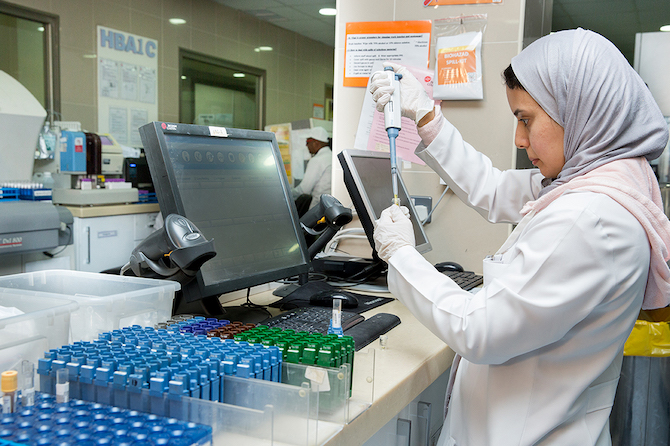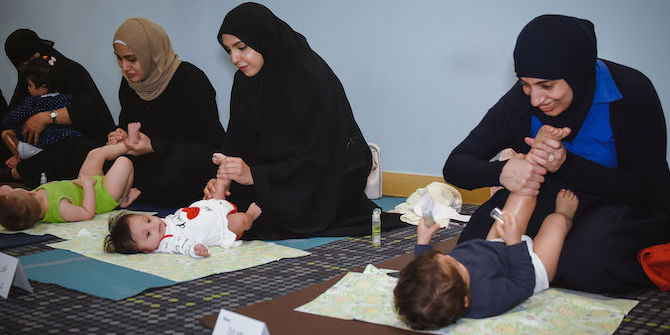by Neil Lee, Husam Arman & Simona Iammarino

Research and Development (R&D) spending – systematic efforts to create and apply new knowledge – is one of the main drivers of innovation and long-term economic success. There is a strong correlation between national R&D spending and GDP per capita. The world’s most successful economies, such as Sweden, tend to have high levels of R&D spending, while countries which have broken into the club of rich nations, such as South Korea, also tend to invest in R&D.
The economies of the Gulf are obvious exceptions. Oil wealth means they have high GDP per capita, but only low levels of R&D spending. Across the OECD, the average share of GDP spent on R&D is around 2.4 percent. But in Kuwait, the figure is a paltry 0.3 percent, according to the World Bank, with private sector R&D likely to be a relatively small share of this.
Does the low level of private sector R&D spending in Kuwait matter? And, if so, how can policymakers encourage further private sector R&D spending? We are investigating these questions in an LSE Kuwait Programme funded project. We’ve conducted workshops with business and government and a survey of large Kuwaiti firms to consider how and why private sector R&D investments should be given more priority in Kuwait.
The rationale for increasing private sector R&D spending is obvious. Kuwait is trying to diversify its economy, partly because of oil price volatility but also in the recognition that technological change could rapidly reduce the viability of an oil-led national economy (particular in the all-important context of climate change). The 2035 economic development strategy sets out the need for a ‘diverse and prosperous economy’ as one of its main goals. Taking a ‘high-road’ approach based on innovation is the best way of doing this, and this approach requires more spending on R&D.
But doing so will be challenging: oil wealth has meant the Kuwaiti economy is in something of a trap, where incentives are locked in for activities to continue just as they are. Innovation is a systemic process: it requires different actors, such as business, universities, and government agencies, to work together. Furthermore, it requires a set of framework conditions, including demand for innovation, finance, skills, and the right culture.
The problem for Kuwait is that many of these conditions don’t work individually, and certainly not as a functioning system. Oil wealth leads to a low-risk business culture which discourages risky R&D investments – and our initial research shows that there is too little acceptance of the need for risks to be taken and the cost of doing so. Senior management of Kuwaiti firms are not incentivised to create new products, and lack the track record of successfully doing so. This may well change as newer generations take positions of power, but it will take time for this to happen. One of the main reason innovation projects go unfunded is because of these cultural issues, and Kuwait has plenty of them. The result is that Kuwaiti firms have an astonishingly low patenting rate.
There are encouraging signs, but not yet a widespread recognition amongst policymakers that R&D matters. There have been plenty of reports on diversification in Kuwaiti, but too little follow-up action. The rolling national development plans have always emphasised the importance of diversification, but lacked the implementation mechanisms and R&D and innovation in particular.
Perhaps a final problem is the sort of role-models there are. There are plenty of examples of countries which have successfully increased private sector R&D investment, developing more resilient and sustainable economies in the future. But few have done so in the context of abundant oil wealth, which locks in problematic incentives, albeit providing resources to overcome them.
There are signs that things may be changing, and R&D and innovation have been discussed intensively as part of the development of the next year 5-year development plan. But for Kuwait to achieve more private sector R&D will require a big push, and plenty of innovative policymaking.
*This blogpost is part of the LSE Kuwait Programme project Towards Promoting Private R&D Investment in Kuwait. Neil Lee, Husam Arman and Simona Iammarino are Principal Investigators on the project.
 Neil Lee is an Associate Professor of Economic Geography in the Department of Geography and Environment, LSE. He tweets at @ndrlee
Neil Lee is an Associate Professor of Economic Geography in the Department of Geography and Environment, LSE. He tweets at @ndrlee
 Husam Arman is an Associate Research Specialist at the Kuwait Institute for Scientific Research (KISR).
Husam Arman is an Associate Research Specialist at the Kuwait Institute for Scientific Research (KISR).
 Simona Iammarino is Professor of Economic Geography in the Department of Geography and Environment, LSE.
Simona Iammarino is Professor of Economic Geography in the Department of Geography and Environment, LSE.






